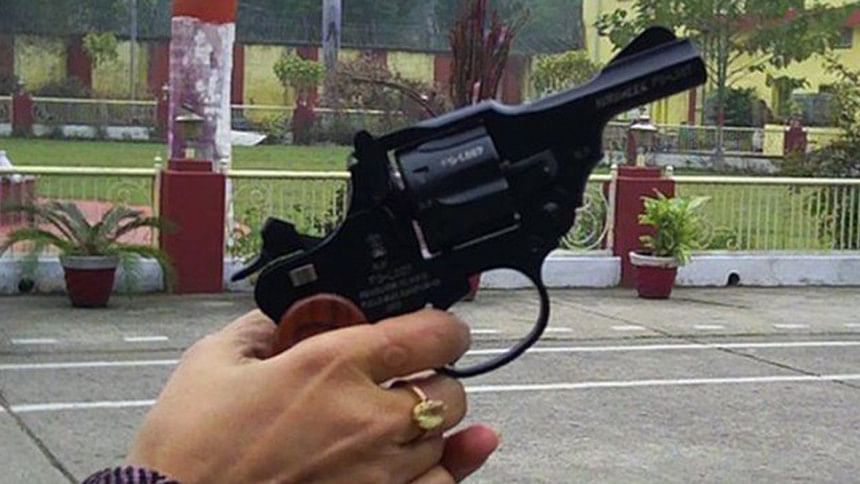Can a piece of jewellery make you safe?

Can wearing a pendant make you safe? Yes - if you believe five 22-year-old Delhi engineering students who have created "Safer".
On the face of it, Safer is a large-ish gem pendant set in steel casing, and worn on a steel chain.
But this piece of attractive jewellery (available in colours like blue sapphire, emerald green and onyx black) has a small triangular chip embedded in the back which, if pressed twice, connects to an app that then sends out an alert to designated mobile phones of "guardians" who can then track the wearer's location and movement on Google Maps.
Paras Batra, the sales head at Leaf, which has created the pendant, says he started thinking about a product to provide safety to women after the December 2012 gang rape of a 23-year-old student on a bus in India's capital, Delhi.
"I live in Munirka, the area in south Delhi from where this young woman boarded the bus in which she was attacked. I was very disturbed by it and felt that we needed to do something about it, to make the city safer for women," he says.
He talked it over with his childhood friend Chiraag Kapil, who brought in his college mates Ayush Banka, Manik Mehta and Avinash Bansal, who then began discussing a product.
"We considered a shock giving jacket, but then we thought how many women would wear a jacket in the city's heat? We considered lots of other ideas and then we thought, women like to wear jewellery and that's how this beautiful pendant was born," says Kapil, who heads Leaf's mobile app development and graphic design team.
Gun, anti-rape bra, pepper spray
Since December 2012, a number of products have been launched with much fanfare to make women safer, but none of them have captured popular imagination. Here's a list of some of the most unusual ideas:

Last year, the state-run Indian Ordnance Factory launched Nirbheek, the country's first handgun for women. The .32-calibre revolver weighed only 500g (1.1lb), was easy to handle, was tiny enough to fit into a lady's purse, and to make it more attractive, was packaged in a maroon jewellery case. Officials said it would help women defend themselves, but critics called it an insult to the memory of the December 2012 Delhi gang rape victim.

Three aeronautical engineering students in Chennai developed a bra designed to deliver a 3800kv electric shock to any would-be rapist, enough to cause severe burns. The anti-rape lingerie could also send a text message to a relative or friend and the local police station, with the GPS co-ordinates of the victim's location, they said.

Last December, police Delhi began distributing 1,000 pepper spray cans among women to be used for their personal safety. Women who wanted a can were asked to submit two passport-size photographs and fill out a form.
The "Safer" pendant has been priced at 3,500 rupees ($53; £34) and ahead of its launch in November, is being sold at a discounted price of 2,700 rupees ($40; £26).
The device has won several Indian and international awards, including the prestigious Lockheed Martin National Innovation Award. Later this month, the young innovators will be at Silicon Valley as one of the "Top 10 Innovators of India".
Since the Delhi rape, a plethora of mobile phone apps and other devices have been launched to make women feel safe in India, but none of them have caught on because either they are impractical or too cumbersome.

Panic-button devices are also not a new concept - they have been used for the elderly and children for many years and in the past couple of years, the idea of a panic button in a pendant or other jewellery has been explored in the US, Singapore and Malaysia, says technology writer Prasanto K Roy.
So what is it that makes Safer different?
"The apps have not worked because the phone is generally kept in the bag or pocket and in distress, crucial time is lost while you find your phone, unlock it, and find the safety app from the millions of other apps on your phone," says Chiraag Kapil.
Also, he says, Safer is "superior" to other pieces of smart jewellery in the market because it has a chargeable battery while other products run on batteries that have to be replaced after a while.
Safer works for up to 10 days on a 15-20 minute charge, says Paras Batra, adding that "it's idiot proof - it will work as long as you don't put it in the microwave".
Roy agrees that it is a good idea to have a trigger outside the phone that is easily accessible, though he says the pendant seems "a little obtrusive" as a piece of jewellery because "it's quite big".
Also, he says a panic button is a good idea, but in India, "we don't have the law-enforcement-response ecosystem - like the US emergency number 911 - for it to be effective".
"Still, an alert to friends and family with location is better than nothing. Sometimes, even a call back from family or friend, in response to an SOS, can save the day," he adds.
The big challenge now for the Safer team is to raise the money to make the product commercially viable.
"We are raising money through crowd funding, we've also managed to interest some investors who have pledged funds. So we hope our dream to put a Safer pendant in every woman's hand will soon become a reality," says Paras Batra.

 For all latest news, follow The Daily Star's Google News channel.
For all latest news, follow The Daily Star's Google News channel. 



Comments